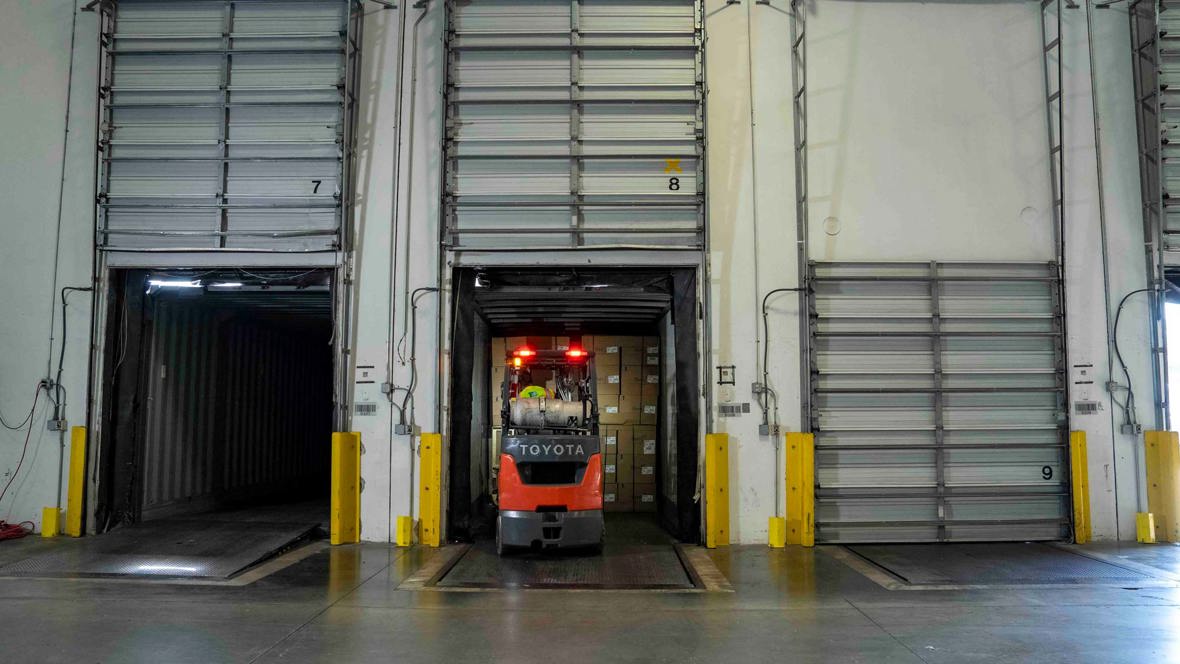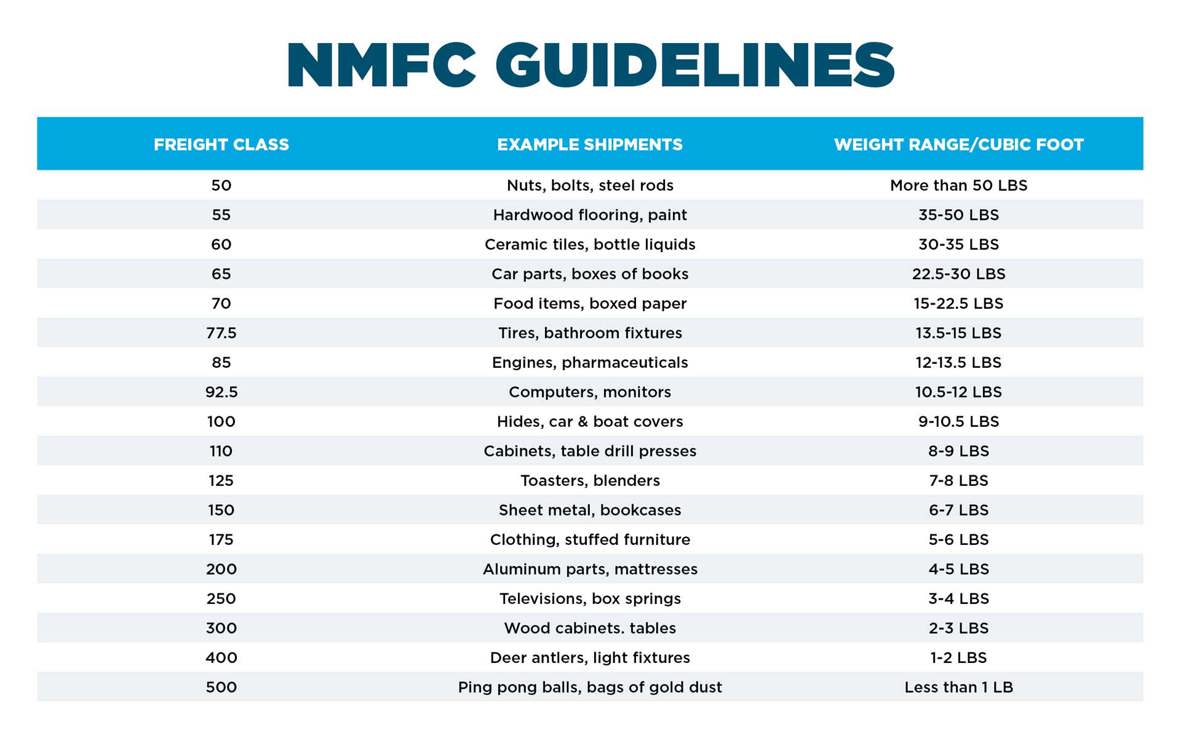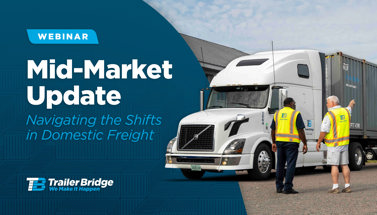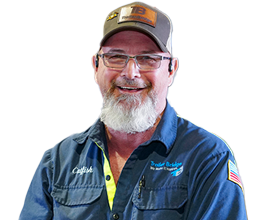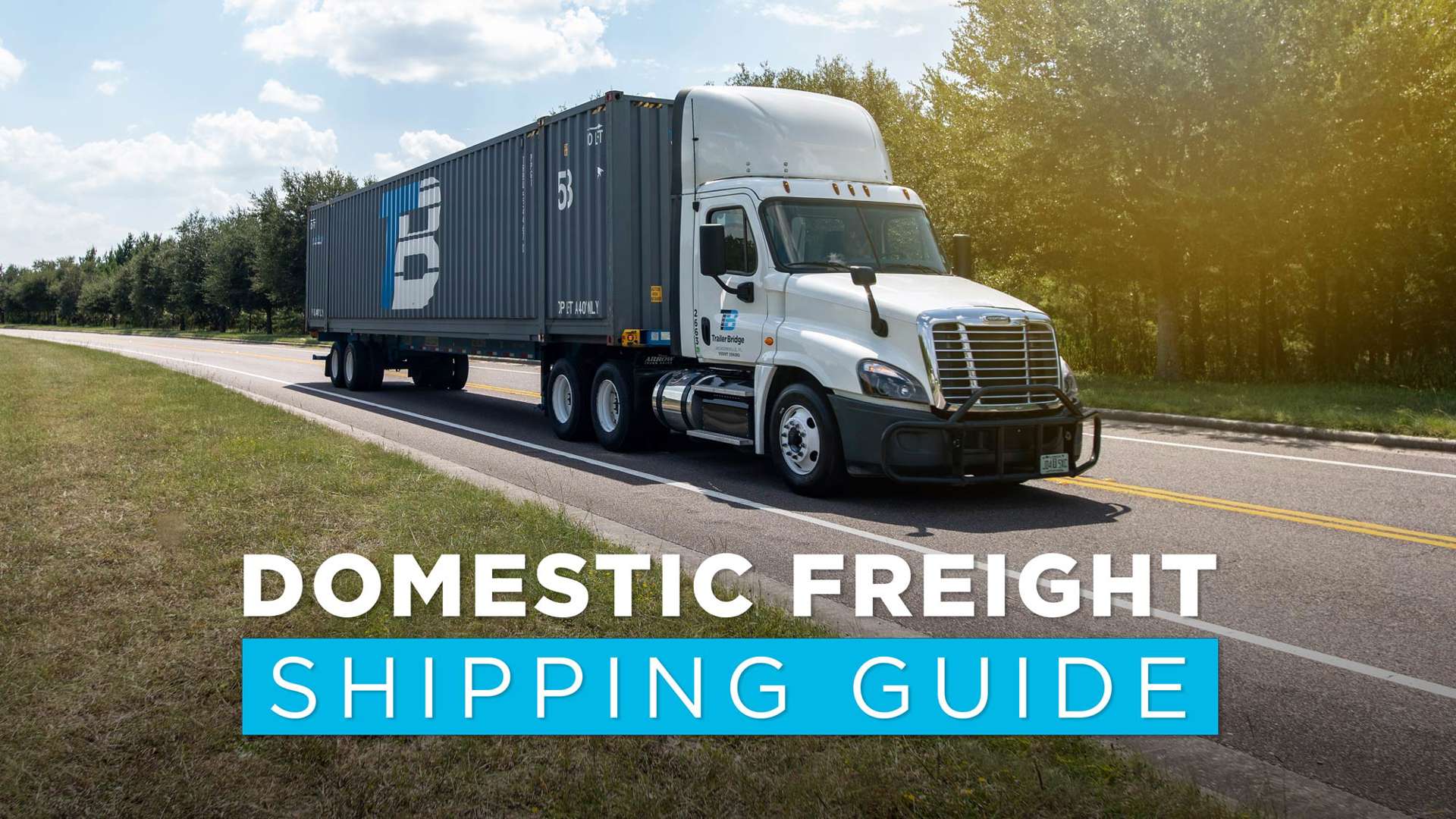
Domestic Freight Transportation Guide
Whether it’s by truck, rail, or a combination of both, there is more than one solution to domestic freight transportation. But with multiple options, it can be hard to know which is the most efficient and economical fit for your supply chain. In this blog, we guide you through this decision by breaking down the most common types of domestic transportation and how to choose the best solution for your business.
Full Truckload (FTL)
Full truckload refers to any shipment that is large enough to fill a full semi-truck trailer (or container), either by weight or volume.
The total weight that a semi-truck is legally allowed to carry is 80,000 lbs. including the tractor, trailer, and freight. The total allowable payload (cargo weight) depends on the type of trailer being used, but is generally between 42,000 lbs. – 48,000 lbs.
The trailer type makes a difference because they are constructed of different materials, with some heavier than others. For instance, an aluminum flatbed trailer is relatively light so it can carry more cargo than dry vans which contain a heavier fiberglass enclosure.
The maximum volume of a load is also dependent on the trailer attachment chosen. In addition to there being different types of trailers, some also come in different sizes. For example, flatbeds are usually 48 ft. but can range from 24-53 ft. in length.
With so many variations, sometimes it is best to consult the experts. If you’re unsure what constitutes a full truckload for your shipment, your logistics provider can guide you on the allowable weight and volume, so you stay compliant with regulations.
FTL Shipping Process
The full truckload process is straightforward and allows you to take advantage of the efficiencies gained from having transportation fully dedicated to your shipment.
1. Pickup
A driver is dispatched to your pickup location at your pre-set time frame to collect your shipment.
2. Over the Road Transport
Once your shipment is loaded on the truck it begins the trip to its destination. Different vocabulary may be used for this part of the process depending on the distance that your shipment is traveling.
- Long haul: This refers to shipments that travel thousands of miles and take multiple days to move from origin to destination.
- Regional: These shipments only travel within a certain region of the country (Northeast, South, Midwest, etc.) and can be driven within a day or two.
- Localized: If you have localized shipments, the origin and destination are close enough for the driver to do multiple shipments in a day. Drayage can be considered a type of localized shipment.
- Dedicated Lane: A dedicated lane is when a driver is assigned to your company and moves your shipments over the same route on a regular basis. This type of haulage can increase efficiency in your supply chain and can be scheduled for lanes of any distance.
3. Delivery
When the driver reaches the destination, your freight is unloaded from the truck and the move is considered complete.
FTL Shipping Equipment
Less Than Truckload (LTL)
Less than truckload (LTL) is a transportation option for shippers who have freight to move, but the amount is not large enough to fill a full truckload. While it can vary, a good rule of thumb for shipments qualifying for LTL is 1-6 pallets or less than 10,000 lbs.
The biggest advantage of LTL is that you only pay for the space that your freight requires, while cargo from other shippers fill the remaining space in the truck.
Some examples where LTL is a cost-effective solution include:
- Small businesses who don’t have enough freight to fill an entire truckload
- E-commerce businesses who need to ship to customers quickly and don’t want to wait until they have enough freight to fill an entire trailer
- Last mile deliveries
- Inventory management moves when a small amount of freight is being moved from one warehouse to another
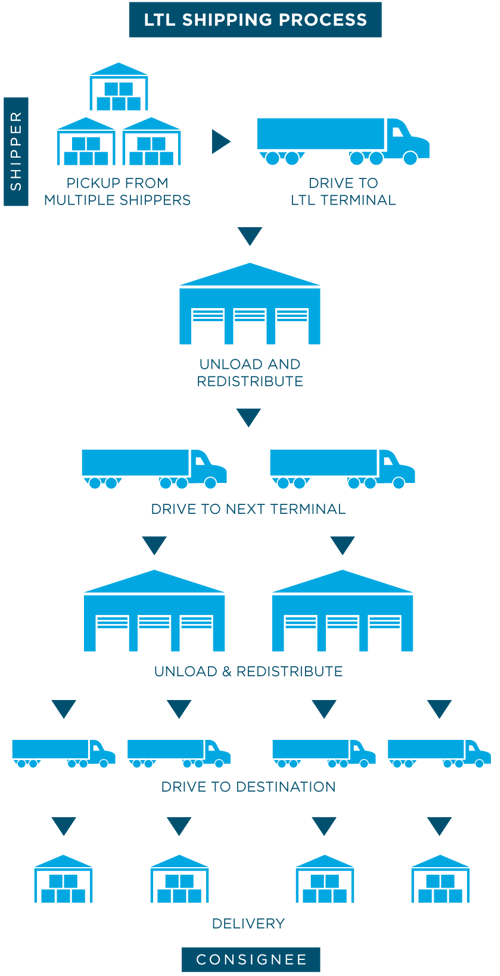
LTL Shipping Process
Since multiple shipments travel simultaneously in LTL shipping, the process is not as straightforward as with FTL. Instead, LTL shipping follows a hub and spoke model for transportation and distribution.
While some carriers will handle your shipment in a direct line from start to finish, others interline freight. Interlining is when one carrier contracts with another to move their customer’s freight at some point in the journey. This can happen during pickup, delivery, or transport in between. This is usually done by smaller carriers to fill geographic coverage gaps but can be used by larger carriers also.
1. Pickup
An LTL truck is sent out to pick up your shipment in addition to others in the same area for transport to a local terminal. These pickups typically happen in the afternoon and start with the pickup location furthest from the terminal. Since freight is being picked up from multiple shippers, you can’t set an exact pickup time. Instead, the LTL carrier will usually provide a pickup window that spans a few hours. Some LTL pickups can be scheduled for the same day, but it is not guaranteed, so it is best to schedule as early as possible.
2. Terminal Arrival and Distribution
Once all shipments have been picked up, they are delivered to the local LTL terminal to be sorted and reloaded into a new truck with other freight that is traveling in the same direction or to the same destination.
3. Additional Terminal Arrival and Distribution
Depending on the distance that your shipment is traveling, it may be delivered to additional LTL terminals for further sorting and reloading into new trucks to get it closer to the destination.
4. Delivery
Once your shipment has reached the final terminal, it will be sorted and placed with other freight in a vehicle for delivery. LTL deliveries are usually arranged in the mornings and shipments furthest from the terminal get delivered first. Like pickups, there is no guaranteed delivery time. If your freight has specific delivery requirements like residential delivery or a lift gate, it may take longer since special equipment is needed.
LTL Shipping Equipment
In addition to full-sized trailers, LTL uses a variety of equipment to get its shipments from point A to point B.
Dry Van Trailers
LTL will often use the same type of dry van trailers used in FTL shipments. But instead of filling it with a single customer’s freight, it is filled with shipments from multiple customers. Trailer lengths used often range from 48 ft. – 53 ft.
Pup Trailers
These trailers are similar to 53’ dry van trailers but are smaller and usually have a lift gate to help load and unload pallets.
Box Trucks
These trucks include a tractor with an attached trailer and come in different sizes to accommodate various weight capacities.
Smaller Trailers in Tandem
This consists of two smaller trailers that are attached to each other with a swivel joint and moved by the same tractor. These trailers are especially useful for extra mobility if freight needs to be delivered to areas that are hard to access.
LTL Freight Shipping Costs
The space your freight occupies is the primary cost determinate, but there are multiple factors that go into your total LTL shipping rate.
Weight: In LTL shipping, the total weight of your shipment includes your freight and the pallets it’s packed on. The palletized freight is charged per hundred pounds, called hundredweight pricing. This weighing system is tiered and the price per hundred pounds decreases the more the shipment weighs.
Density: Density is the amount of space your shipment occupies per pound, calculated by dividing the total weight by its volume (length x width x height). This directly corresponds to the freight class your shipment is assigned, where high density items cost less to ship than low density items.
Freight Class: Each LTL shipment is assigned to a class as defined by the National Motor Freight Classification (NMFC) standard. This system includes 18 classes, numbered from 50 (lowest cost) to 500 (highest cost). Freight class is based on shipment density, handling, stowability, and liability.
Distance: The further your shipment travels, the more it will cost. This is because longer distances require more terminal transfers.
Base Rates: Minimums, also known as Absolute Minimum Charge (AMC) is the lowest price a carrier will charge using LTL shipping rates. Each carrier will have their own base rates and minimums so be sure to be aware of these policies when planning your shipment.
LTL Accessorial Fees
In addition to the standard transportation cost, there are several services that can be purchased for LTL shipments at an additional charge.
- Reweigh/ Reclassification: It is extremely important that you provide your carrier with the correct weight and NMFC classification for your freight. If the weight of your freight isn’t accurate or the classification must be changed after pickup, you will be charged a fee for the difference in cost.
- Liftgate: This equipment lowers pallets from deck height to the ground and is required whenever your shipment is being picked up or delivered to a location without a loading dock.
- Inside Pickup/ Delivery: When the driver must enter a building to retrieve or deliver the freight being moved.
- White Glove Service: Ensures that additional care is taken when handling your freight throughout shipping.
- Limited Access: Required when the pickup or delivery location is in a hard to access area like construction zones, strip malls, etc.
- Residential Pickup/ Delivery: When an LTL shipment is being picked up or delivered to a residential area rather than a business or warehouse.
- Hazmat: Like full truckload shipping, LTL shipping charges an additional fee to handle shipments containing hazardous materials.
- Overlength: This charge compensates for the extra amount of space an especially long piece of freight takes up when being shipped.
- Tradeshow: Many tradeshows have specific requirements for delivery and pickup for items used at the event and the location for shipments may be hard to access.
- Protect from Freezing: Since the equipment used in LTL does not regulate the temperature of the freight, this service ensures extra measures are taken to prevent freezing when shipping in cold weather.
Pros & Cons of Less Than Truckload Shipping
Pros
- Cost: Only paying for the space you need for a freight shipment is much more cost effective than paying for space that you won’t use with a full truckload.
- Environmentally Friendly: Multiple shippers consolidating packages into a single load means there are less trucks on the road than if they were shipped separately.
- Specialty Services: LTL can accommodate specialty services not often offered with truckload shipping like inside pickup/delivery and white glove service.
Cons
- Less Predictability: Since multiple shipments are being handled at once, pickup, delivery, and transit times are harder to predict. This requires that you can be more flexible when shipping LTL.
- Increased Handling: LTL shipments must go through multiple trucks and terminals on the way to their destination which increases the risk of damage in transit.
Intermodal is the movement of freight in containers or trailers over two or more modes of transportation such as air, rail, truck, and ship.
While intermodal can include any combination of these modes, the most common pairing is rail and truck, which we will be focusing on for domestic transport. In this scenario, the shipment travels by rail for most of its journey, and trucks provide drayage for the short trip to and from the rail facility.
When shipping intermodal, you will need to use an intermodal provider. Railroads do not work directly with individual shippers, so the intermodal provider’s role is to coordinate the shipment and act as a liaison between the shipper and rail company. They also arrange dray services to move your cargo to and from the rail terminal.
Intermodal Shipping Process
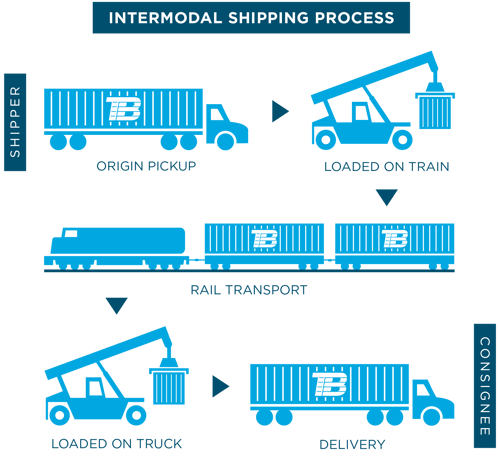
1. Pickup & Origin Dray
A truck driver (also known as a drayage carrier) is dispatched to pick up an empty container or trailer and take it to the shipper’s location. For domestic intermodal, the most common container size is 53’. Once the freight has been picked up, the drayage carrier transports it a short distance from the shipper’s location to the intermodal terminal.
2. Rail Transportation
Once the shipment arrives at the intermodal terminal, it is transferred from truck to train, where it spends most of its journey traveling to the next destination by rail. There are two ways of loading a shipment on a rail car, based on the type of equipment used.

Container on Flat Car (COFC)
If your freight is loaded in a shipping container, the container is removed from the chassis and placed on a flat rail car. This is usually preferable since containers can be double stacked for additional capacity.
Trailer on Flat Car (TOFC)
If your shipment is loaded into a trailer, the entire trailer is detached from the tractor and loaded on a flat rail car. Trailers do not have the ability to be stacked like containers.
3. Destination Dray & Delivery
Once the shipment arrives at the destination intermodal ramp, a drayage carrier is dispatched to pick it up and drive it to the delivery location.
Drayage
Drayage is the movement of freight (typically by truck) over a short distance. The definition of drayage may be simple, but it is an important part of the supply chain. It is integral to intermodal operations but can also be used to connect pieces of the supply chain for other purposes.
These are some common scenarios where drayage may be used for domestic shipments:
- Final mile delivery from railroad/ port/ warehouse to receiver
- Shipper to railroad at the beginning of intermodal
- Railroad to receiver at the end of intermodal
- Port/rail to warehouse for transloading or cross-docking
Intermodal Pricing
The cost of intermodal includes the total cost of all transportation modes involved in the move, plus fuel. For a basic door-to-door intermodal move, this would include origin drayage, rail transportation, and destination drayage, plus the cost of fuel.
Fuel pricing is based on the National Fuel Index, published by the U.S. Energy Information Administration (EIA). This tool provides the weekly average of fuel prices in different markets across the country and is used as a reference point by transportation providers.
Pricing Models
Like full truckload, intermodal rates can be calculated using multiple methods, based on the customer’s needs. These include spot, contract, and project rates.
Spot Rates
A spot rate is a one-time quote provided for a specific shipment. In this scenario, you must request a quote from your intermodal provider who will provide pricing based on the current market rates.
Contract Rates
Contract rates are provided as long-term pricing for consistent freight capacity over specific lanes. Since there are multiple steps involved in intermodal transportation, the quoting process for contract rates is different than other direct modes of transport, such as trucking.
To receive a contract rate, the first step is to contact your intermodal provider. The intermodal provider then requests contract pricing from the rail line on your behalf. Once the rail line returns their rate, the intermodal provider adds the estimated cost of dray services and fuel on their end. The final rate is then calculated and returned to you for review and approval.
Project Rates
Project rates are used for a series of intermodal moves that are larger than a single shipment, but don’t have the length or consistency necessary for a contract rate. When quoting a project move, your intermodal provider will give you the total cost based on the scope of service needed.
Intermodal Accessorial Fees
These are some common accessorial fees that you may see when shipping intermodal:
- Demurrage: Charged when full containers are not picked up from the carrier’s location (either railroad or shipyard) within the allotted number of free days after arrival.
- Detention/Storage: Charged by drayage drivers when they must spend extra time waiting for cargo to be loaded or unloaded after the allowable amount of free time (usually 1-2 hours). When containers arrive at the destination railyard, the sender has a short window of time to pick them up before being charged for storage.
- Equipment Order Not Used: This is the same concept as a Truck Order Not Used (TONU) in trucking. If a pickup is scheduled for an intermodal move and is then cancelled after dispatch, a fee will be charged to the shipper.
Pros and Cons of Intermodal Transport
Pros
- Cost Savings: One of the biggest incentives for shippers to use intermodal is the possibility for cost savings. When shipping distances of 500 miles or more, intermodal can be less expensive than OTR trucking traveling the same distance.
- Reliable Capacity: A single train can carry hundreds of containers and is rarely low on capacity, which makes intermodal a good option for volume shippers and shippers short on truck capacity. Containers can even be double stacked on rail cars for shippers who need more space.
- Sustainability: Intermodal has increased fuel efficiency and can carry the equivalent of 280 truckloads which cuts down on the number of vehicles on the road.
Cons
- Accessibility: Freight pickup and delivery locations must be within 100 miles of an intermodal ramp to maintain the cost savings benefit of shipping by rail, which limits the number of shippers who can take advantage. Most ramps are also located near densely populated cities where the shipping demand is higher, leaving many rural shippers out of range.
- Limited Flexibility: Shipping routes are physically limited to areas where track is laid, and the transportation timeline is determined by the railroad’s schedule instead of your business operations.
- Speed: Since intermodal involves moving freight between multiple modes of transportation, the complexity can result in longer transit times.
Choosing the Best Domestic Transportation Solution for Your Business
As you can see, there are many factors to consider when choosing how to move your domestic freight. To help you weigh your options, let’s review the methods discussed and best-fit scenarios for each.
Full Truckload (FTL)
- You want a service that is dedicated to your shipment
- You need to schedule specific pickup and delivery appointment times
- You want the efficiency of your freight going straight from origin to destination
- You want the security of limited handling of your freight
Less Than Load (LTL)
- You have less than 10 pallets or 10,000 pallets of freight to ship
- You have a flexible pickup and delivery window
- You need specialized services like residential delivery, white glove service, trade show delivery, etc.
- Your freight can withstand a lot of handling throughout the shipping process
Intermodal
- Your freight is traveling over 500 miles for maximum cost savings
- Your pickup and delivery location is within 100 miles of an intermodal facility
- You have a flexible pickup and delivery window
- You want a transportation solution that has consistent capacity
- You are looking for a more environmentally conscious transportation option
If you still aren’t sure which is the best solution for your needs, you can always ask your logistics partner and they will be happy to guide you through the process.



